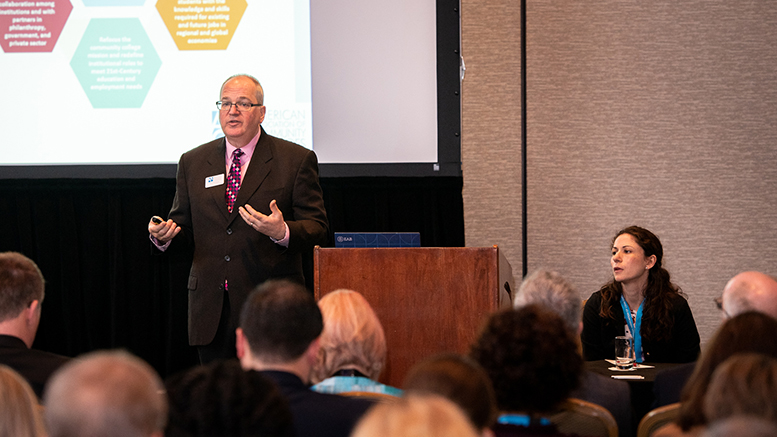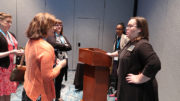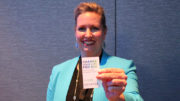Meeting the American Association of Community Colleges’ (AACC) recommendations for structural reforms, including the guided pathways model, means colleges need to become more agile, according to Magda Rolfes, practice manager for the Community College Executive Forum at EAB.
Some of the ways to do that include creating partnerships to improve programming, increase collaboration, step up outreach to students and reform developmental education, Rolfes said during a session the AACC annual convention in Orlando, Florida.
AACC leads the way
Kent Phillippe, AACC associate vice president for research and student success, outlined the reforms proposed by the association, which started with President Walter Bumpus’ formation of the 21st-Century Commission in 2011 to determine how colleges need to change to meet 21st-century demands.
The commission’s report offered several recommendations that led to such initiatives as the AACC Pathways Project, which calls for streamlining relevant instructional programs; the Right Signals Initiative to understand competencies; the Voluntary Framework of Accountability as a way to measure student success and provide colleges with better data for institutional improvement; and a series of conversations with K-12 leaders on readiness.
One ambitious goal in that report called for increasing the national community college completion rate by 50 percent by 2020. “We are probably not going to get to that 50 percent goal, but we are seeing a lot of progress,” Phillippe said.
Colleges did make dramatic changes to improve completion, including adopting pathways and improvements in student support structures, he noted.
“Institutional change is hard, but it is important that it is starting to bear fruit,” said Phillippe, adding that he expects to see even more improvements and results by 2025.
Career relevance
Colleges must be more agile to respond to demographic and workforce trends, such as the sharp decline in adult students, Rolfes said. Four-year institutions also saw a decline in adult learners, but community colleges lost 436 adults for every one adult lost by four-year colleges.
EAB projects community colleges will see another 4.3 percent decline in adult students between 2019 and 2021. And beginning in 2025, community colleges will see big decline in first-generation students, Rolfes said.
College leaders can reverse those trends by changing their marketing strategies, she said. “Colleges need to tell our story better,” she said.
Community colleges are still primarily marketing themselves to prospective students by emphasizing their low prices, but “today’s students want more than that,” Rolfes said.
“Community colleges are struggling to appeal on career relevance,” she said.
She urged two-year colleges should stress their long-term benefits, which is what many four-year institutions are doing, Rolfes added. For example American University in Washington, D.C., promotes opportunities for internships and study abroad programs. And when Memorial University in Canada sent students to a career fair, some were given scripts describing the content of the courses they took and others were provided scripts outlining the competencies they acquired. The students who discussed competencies with prospective employers were more likely to get job interviews.
Rolfes cited data from Public Agenda that found 70 percent of prospective students want to learn skills useful for the workplace. Less than 7 percent of community colleges, however, reported the majority of their programs have an employer-based internship or apprenticeship program.
Collaboration, not competition
To respond rapidly to changing workforce needs, colleges need to “refresh programming through shared partnerships,” Rolfes said.
About 55 million jobs will be created by 2020, including 31 million of them due to baby boomer retirements, she said. Twenty million of those jobs will require the type of credentials provided by community colleges.
Because some of the jobs held by boomers will be replaced by automation – such as truck driving – community colleges will need to incorporate more information technology and digital skills into their training programs.
Rolfes offered an example of how one college is realigning its education programs to better align them with future workforce needs. West Hills Community College District in California is in a rural area with an unemployment rate double the national average. Only 43 percent of residents in its service area have broadband access, there are no software development employers in the area, and finding qualified faculty for computer programs was challenging.
The college partnered with Bitwise Industries, an incubator for technology startups that need to fill its regional pipeline for IT workers, to establish a coding academy. The result is a layered curriculum, Rolfes said.
The college teaches basic computer coding courses. Students are bused to the Bitwise facility where they take more advanced 300-level IT course from instructors hired by the company. The arrangement allows West Hills to have a dynamic curriculum without taking on the risk of teaching high-level courses, Rolfes said, and the coding academy led to much higher retention rates.
“Community colleges are the nexus” between K-12 education, employers, communities and four-year colleges, but “that’s not the story we tell,” Rolfes said.
Instead of competing with one another, colleges would do better to build networks and “make collaboration the norm,” she advised.
The Collegiate Consortium for Workforce and Economic Development in Philadelphia – which includes two-year and four-year institutions – is a good example of how higher education institutions can work together to address employers’ challenges, Rolfes said. It serves as a single point of entry for employers’ training needs. When an employer needs a training program, the consortium determines which education institution can provide it, based on expertise and space on campus.
Student outreach
Community colleges also need to do a better job of engaging students and improving their access to support services, Rolfes said. She cited Davidson County Community College in North Carolina for “meeting students where they are.”
Because students are reluctant to go out of their way to talk to an advisor and don’t want to waste time standing in line, Davidson set up temporary advising stations in main thoroughfares next to classrooms to increase advisors’ touchpoints with students as they stop in the hall for an informal chat.
“This is the type of cultural shift that can happen when people bump into each other,” Rolfes said.
Another way for a college to become more agile is to “break the reliance on traditional sequential developmental education based on placement tests,” Rolfes said. More than two-thirds of students take at least one development education course, and most of them still haven’t passed development education within three years.
She called for community colleges to stop using a single test to determine placement and instead use multiple measures, which colleges are increasingly doing. Even adding high school grade point averages to the placement process makes a big difference in passing rates, she noted.





